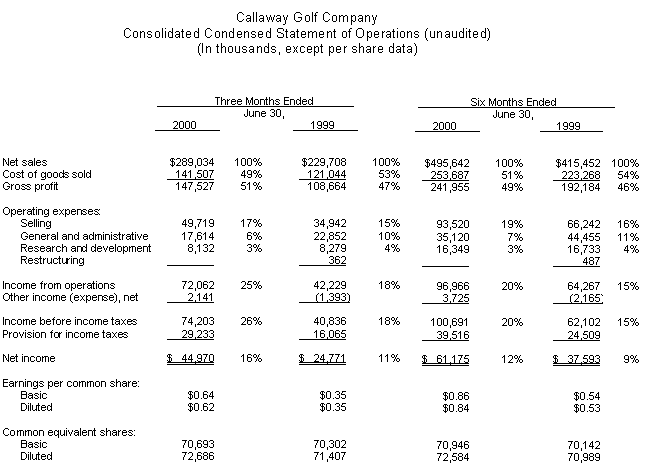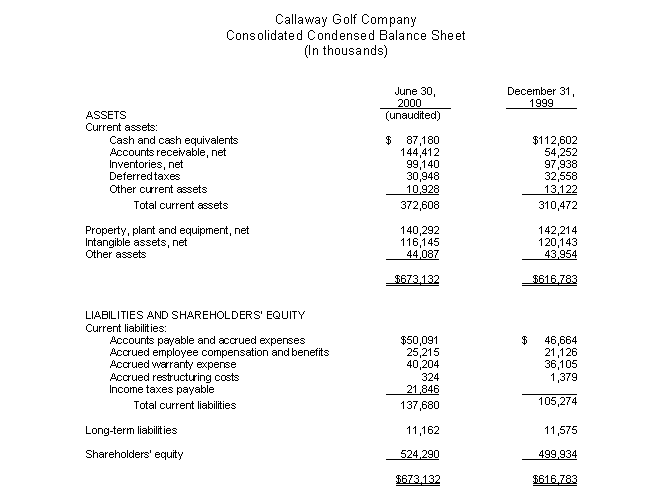Callaway Golf Reports Record Revenues For Second Quarter, Net Income Up 82%, Earnings Per Share Up 77
CARLSBAD, California/ July 26, 2000/ Callaway Golf Company (NYSE:ELY) today reported net sales of $289.0 million for the second quarter ended June 30, 2000, an increase of 26% over net sales of $229.7 million reported in the second quarter of 1999. Net income increased 82% to $45.0 million in the second quarter, from $24.8 million in the second quarter a year earlier. Earnings per diluted share increased 77% to $0.62 in the second quarter of 2000 from $0.35 in the second quarter of last year.
For the six months ended June 30, 2000, net sales increased 19% to $495.6 million from $415.5 million for the same period in 1999. Net income increased 63% to $61.2 million from $37.6 million for the six months ended June 30, 2000 and June 30, 1999, respectively, and earnings per diluted share increased 58% to $0.84 for the six months ended June 30, 2000, from $0.53 for the six months ended June 30, 1999.
"We are very pleased and excited about our Company and its long term prospects," said Ely Callaway, Founder, Chairman and CEO of Callaway Golf. "Callaway Golf’s golf club business is enjoying record sales and profitability, with net sales in the first half of the year approaching $500 million. The new "Rule 35™" golf ball is, in our opinion and in the opinion of many others, a breakthrough in ball performance with great acceptance by amateurs and professionals alike. Our business is so strong that even with the investments and expenses associated with the start-up of our brand new golf ball operations, we expect to see about a 40% growth in overall company earnings per diluted share this year. Once again, these results demonstrate, in our opinion, the unprecedented power of the Callaway Golf brand around the world.
"The Company’s golf club business has been exceptionally strong," continued Mr. Callaway. "Revenues from golf club sales in the second quarter totaled $278.5 million – the highest for any quarter in our Company’s history. This record quarter, combined with a strong first quarter in golf club sales, gave us golf club revenues for the first half of 2000 totaling almost one half billion dollars at wholesale. To keep up with this demand, we boosted golf club production in the first six months of 2000 by 30% while reducing manufacturing costs per unit produced by over 22%. Our pre-tax income, before corporate allocations, for the second quarter on the golf club business made this one of the most profitable periods we have ever experienced in our golf club operations.
"On the other hand, trying to satisfy the market’s desire for the recently introduced "Rule 35™" golf balls has been a challenge," continued Mr. Callaway. "We are convinced, based upon feedback from professionals and amateurs alike, that we have developed and brought to the market a superior golf ball that delivers Complete Performance™ for most golfers. This has enabled us to achieve a U.S. market share, as reported by an independent market information company, that exceeds those of other new golf ball entrants that had a year’s head start on us. However, we are not satisfied with the ramp up of our new production facility and our limited ability to satisfy the demand that this new golf ball has created. These production and operational challenges continue to be realistically addressed and, with a lot of hard work and a little luck, we think we will be able to put these problems largely behind us this year."
"Our second quarter golf ball net sales of $10.5 million were up 76% over the first quarter, but were less than we had expected," said Chuck Yash, President and CEO of Callaway Golf’s wholly-owned subsidiary, Callaway Golf Ball Company. "Production challenges in our new plant continued to keep our costs at levels that were higher than we wanted. This resulted in a pre-tax loss of $13.4 million, before corporate allocations, for the quarter on our golf ball business. The loss for the first half of the year was $28.0 million. Due to these production problems, golf ball sales expectations for the full year have been adjusted to approximately $45 million. While these sales numbers are below our earlier expectations, we think it significant to note that these results would represent, to our knowledge, by far the largest dollar amount of first-year sales ever achieved by any new entrant in the golf ball industry."
Earnings in the second quarter were affected by the repurchase during May of approximately 2.6 million shares of the Company’s common stock at an average price of $19.37 per share (the Company did not purchase shares during its "dark period" at the end of the quarter and continuing through the release of its earnings). The stock repurchase contributed approximately $0.01 per diluted share to the Company’s earnings for the quarter. Before the end of the year management may purchase up to $50 million in additional shares, in open market or private transactions, under the authority granted by the Board of Directors in May of 2000.
Net sales of $289.0 million for the second quarter of 2000 were comprised of: $146.2 million of Great Big Bertha® Hawk Eye®, ERC™, and Big Bertha® Steelhead Plus™ Metal Woods; $104.1 million of Great Big Bertha® Hawk Eye® Tungsten Injected™ and Big Bertha® Steelhead™ X-14™ Irons; $18.4 million of Odyssey® and Callaway Golf® putters; $10.5 million of golf balls, and $9.8 million of other sales. For the second quarter of 2000 vs. the second quarter of 1999, the Company’s U.S. sales increased 14% to $154.2 million from $135.3 million, and international sales increased 43% to $134.8 million from $94.4 million.
Net sales of $495.6 million for the six months ended June 30, 2000 were comprised of: $246.3 million of Great Big Bertha® Hawk Eye®, ERC™, and Big Bertha® Steelhead PlusÔ Metal Woods; $182.6 million of Great Big Bertha® Hawk Eye® Tungsten Injected™ and Big Bertha® Steelhead™ X-14™ Irons; $29.4 million of Odyssey® and Callaway Golf® putters; $16.5 million of golf balls, and $20.8 million of other sales. For the first six months of 2000 vs. the first six months of 1999, the Company’s U.S. sales increased 15% to $272.4 million from $236.3 million, and international sales increased 25% to $223.2 million from $179.2 million.
Cost of goods sold as a percentage of net sales was 49% in the second quarter of 2000, versus 53% in the comparable period of 1999. This improvement was primarily attributable to a reduction in golf club manufacturing component, labor and overhead expenses, offset by higher than expected golf ball manufacturing costs.
Selling expenses in the second quarter increased to $49.7 million (17% of net sales) from $34.9 million (15% of net sales) in the second quarter of 1999. The increase was primarily attributable to additional expenses associated with sales of golf balls, and expanded golf club sales activity in the Company’s Japanese subsidiary.
General and Administrative expenses for the second quarter of 2000 decreased 23% to $17.6 million (6% of net sales) from $22.9 million (10% of net sales) in the comparable quarter of 1999. This decrease is mainly attributable to the shifting of costs associated with the Company’s golf ball pre-production period – i.e., the costs related to the production and the sale of golf balls during the quarter are now included in cost of goods sold rather than G&A.
"As we said last April, production costs for the year for our golf ball will be greater than our initial expectations due to the unique nature of our new golf ball design, the commencement of operations at a state-of-the-art manufacturing facility built from scratch, and our absolute requirement to produce and ship only a quality product worthy of the Callaway Golf brand name," reported Mr. Yash. "We are encouraged by the progress we are making, and expect that pre-tax losses, before corporate allocations, on our golf ball operations in the remaining half of the year could range from $15 to $18 million – an increase over previous expectations but considerably less than the losses in the first half of the year."
"Demand for our golf clubs has been very strong in the first half of 2000, and our manufacturing operation has been able to produce and ship record numbers of golf clubs to satisfy that demand," continued Mr. Callaway. "These increased golf club sales, combined with reasonable controls on our costs, have permitted us to report better than expected earnings for the second quarter in a row despite our golf ball losses. However, we anticipate that these strong early season golf club sales will cannibalize sales we otherwise would have expected to make in the third and fourth quarters – quarters that are traditionally affected by seasonality in any event – and so it is unlikely that we can continue to sustain club sales at a sufficient level to offset golf ball losses in these later quarters. Despite this, we still expect our earnings per diluted share for the year will be approximately 40% above last year."
Callaway Golf's "Rule 35™" golf ball has had a successful launch on the Professional Tours since it's introduction in January 2000. Callaway Golf staff professional Annika Sorenstam has four wins using the ball, including back to back wins where she used both the Firmfeel™and Softfeel™ ball in alternate weekends. Of the 46 professionals who put a "Rule 35™" ball in play during the weekend of July 22-23, only 27 were Callaway Golf staff professionals paid to endorse and use the ball. Recently, PGA European Tour star and Callaway Golf staff professional Colin Montgomerie switched to the "Rule 35™" ball, as did golf's most popular champion, Arnold Palmer.
In accordance with the Company’s dividend practice for 2000, the dividend for the second quarter will be determined by the Board of Directors at its meeting in August, 2000.
Callaway Golf Company makes and sells Big Bertha® metal woods and irons, including Great Big Bertha® Hawk Eye® Titanium Metal Woods, Big Bertha® Steelhead Plus™ Stainless Steel Metal Woods, ERC™ Forged Titanium Drivers, Great Big Bertha® Hawk Eye® Tungsten Injected™ Titanium Irons, Big Bertha® Steelhead™ X-14™ Stainless Steel Irons, Odyssey® Dual Force® and TriForce™ Putters with Stronomic® inserts, Odyssey® White Hot™ Putters, and Callaway Golf® and Bobby Jones® Putters. Callaway Golf also makes and sells Callaway Golf® Rule 35™ Firmfeel™ and Softfeel™ golf balls.
Statements used in this press release that relate to future plans, events, financial results or performance are forward-looking statements as defined under the Private Securities Litigation Reform Act of 1995. Actual results may differ materially from those anticipated as a result of certain risks and uncertainties, including but not limited to market acceptance of current and future products, including its golf ball, seasonality, adverse market and economic conditions, competitive pressures, and costs and potential disruption of business as a result of the transition of the Company’s Japanese distribution to a wholly-owned subsidiary, delays, difficulties or increased costs in the manufacturing of the Company’s products, including its golf ball, or in the procurement of materials needed to manufacture the Company’s products, as well as other risks and uncertainties detailed from time to time in the Company’s periodic reports on Forms 10-K, 10-Q and 8-K filed with the Securities and Exchange Commission. Readers are cautioned not to place undue reliance on these forward-looking statements, which speak only as of the date hereof. The Company undertakes no obligation to republish revised forward-looking statements to reflect events or circumstances after the date hereof or to reflect the occurrence of unanticipated events.
For more information about Callaway Golf Company, please visit our website at www.callawaygolf.com. For more information about Odyssey Golf, please visit our website at www.odysseygolf.com.

